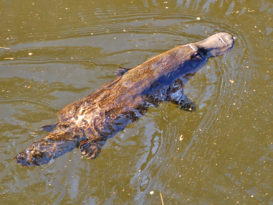- Series:Animals, Transcript English
Genesis 1:24
“And God said, Let the earth bring forth the living creature after his kind, cattle, and creeping thing, and beast of the earth after his kind: and it was so.”
 Australia has more than its fair share of unusual animals. Probably the most unusual of all is the platypus. Indeed, when scientists in Britain were first shown platypus skins in 1799, they believed it to be a fake, having been made of several animal parts sewn together!
Australia has more than its fair share of unusual animals. Probably the most unusual of all is the platypus. Indeed, when scientists in Britain were first shown platypus skins in 1799, they believed it to be a fake, having been made of several animal parts sewn together!
Of course, it is a genuine species, but, even so, it contains some parts that are not usually expected together. It has a bill like a duck (hence its popular name, the duck-billed platypus), its body is furry, like a mammal, but it can deliver a reptilian-like venom. And, famously, it lays eggs like a bird.
The eggs are more like those of a bird than a reptile. Reptile eggs have a larger yolk than birds, but the platypus egg yolk is small and does not contain as much nutrition as that of a reptile. The reason for this seems clear. Baby platypuses are nourished by their mother with milk.
The platypus is classed as a mammal, but is classified into a separate group of mammals, called monotremes. The other creature in this group is the echidna, which looks and behaves nothing like the platypus, apart from the fact that it lays eggs. Evolutionists believe that this group of mammals is left over from the early evolution of mammals from reptiles. In fact, the platypus appears to be uniquely designed by God, filling a niche in the ecology of Australia that belongs to no other creature.
Author: Paul F. Taylor
Prayer: We are constantly amazed, Lord, at Your wonderful creation. You have made all things, so that we are without excuse. Amen.
Ref: Carter, R. (2008), Platypus thumbs its nose (or bill) at evolutionary scientists, < https://creation.com/platypus-thumbs-its-nose-or-bill-at-evolutionary-scientists >, accessed 9/29/2018. Image: Stefan Heinrich, CC BY-SA 2.0 (Germany).
